AUDI A7 2015 Owners Manual
Manufacturer: AUDI, Model Year: 2015, Model line: A7, Model: AUDI A7 2015Pages: 316, PDF Size: 78.09 MB
Page 251 of 316
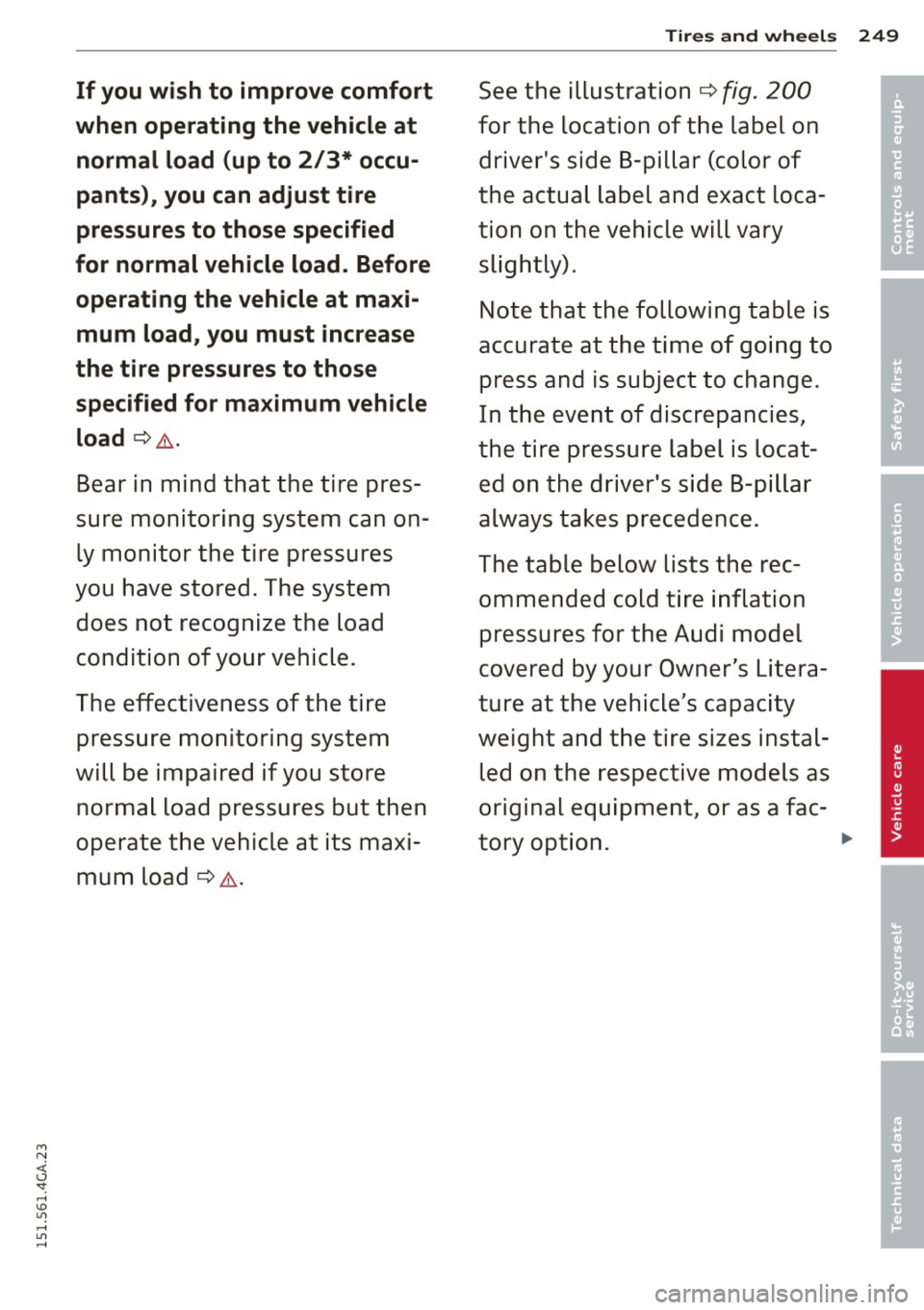
M N <( (.J
'SI: ,...., \!) 1.1'1 ,...., 1.1'1 ,....,
If you wish to improve comfort
when operating the vehicle at normal load (up to 2/3* occu
pants), you can adjust tire
pressures to those specified
for normal vehicle load. Before
operating the vehicle at maxi mum load, you must increase
the tire pressures to those
specified for maximum vehicle load
c> .&. .
Bear in mind that the tire pres
sure monitoring system can on
ly monitor the tire pressures
you have stored. The system does not recognize the load
condition of your vehicle.
The effectiveness of the tire pressure monitoring system
will be impaired if you store normal load pressures but then
operate the vehicle at its maxi
mum load
c> .&. .
Tires and wheels 249
See the illustration c> fig. 200
for the location of the label on
driver's side B-pillar (color of
the actual label and exact loca
tion on the vehicle will vary slightly).
Note that the following table is
accurate at the time of going to
press and is subject to change.
In the event of discrepancies,
the tire pressure label is locat ed on the driver's side B-pillar
always takes precedence.
The table below lists the rec ommended cold tire inflation pressures for the Audi model
covered by your Owner's Litera
ture at the vehicle's capacity
weight and the tire sizes instal
led on the respective models as
original equipment , or as a fac-
tory option. ..,.
•
•
'
Page 252 of 316

250 Tires and wheels
Model/ Tire designation Tire pressure
Engine normal load condition
full load condition
fronta> reara>
front rear
PSI kPA PSI kPA PSI kPA PSI kPA
A7: 235/55 Rl 7 99Y
32 220 29 200 35 240
38 260 3.0 liter High Performance
6-cylinder
255/45 R18 99H
All Season
32 220 29 200 35 240 38 260
255/45 Rl8 99Y 32 220 29 200
35 240
38 260
High Performance
255/40 R19 lOOH XL
35 240 32 220 38 260 280 All Season 41
255/40 Rl9 lOOY
XL
36 250 32 220 38 260 41 280 High Performance
265/35 R20 99H XL
35 240
32 220 38 260 41
280 All Season
265/35 R20 99Y XL
36 250 32 220 38 260 41
280 High Performance
57: 255/40 R19 lOOY XL
39 270
33 230
42 290 42 290 4.0 liter High Performance
a-cylinder 265/35 R20 99Y XL
High Performance
41 280 35 240 44 300 44 300
XL= reinforced or extra load tire. It may also appear as xl, EXTRA LOAD, or RF on the tire side-
wall.
a) normal load
condition¢ page 247.
The correct tire pressure for the
spare wheel is located on a la
bel on the driver's side B-pillar.
Because technical changes may
be made to vehicle equipment
during the model year, always
compare the tire size designa
tion on the tire pressure label
on your vehicle with the tires on
your vehicle. Make sure that the
tire size information on the ve
hicle label is the same as the
size of the tires on the vehicle. This is especially important if
the vehicle belongs to someone
else or you bought the vehicle
with different rims/tires or you bought the vehicle as a previ
ously owned vehicle.
Remember, your safety and
that of your passengers also de
pends on making sure that load
limits are not exceeded. Vehicle
load includes everybody and ev
erything in and on the vehicle.
These load limits are
Page 253 of 316
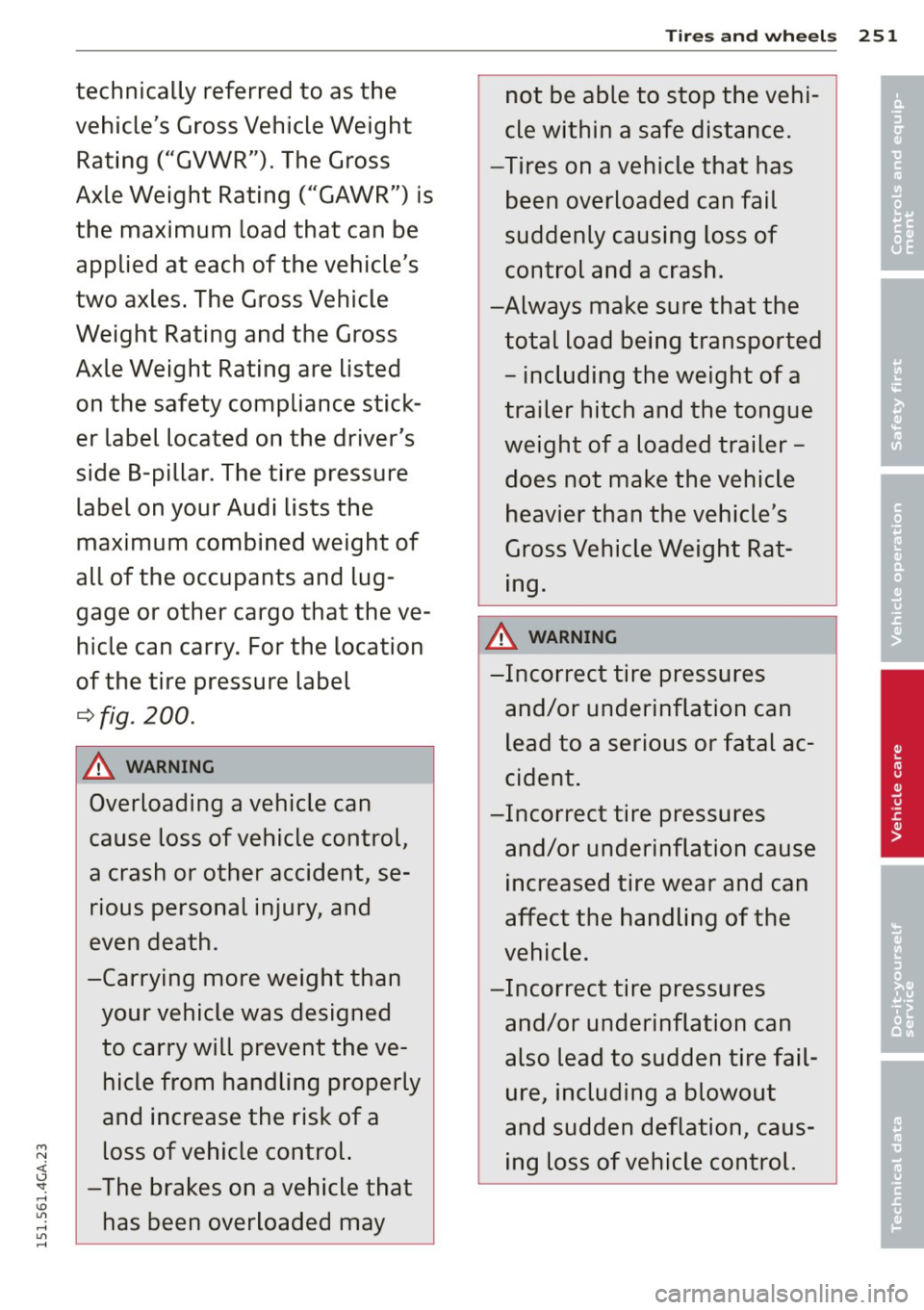
technically referred to as the
vehicle's Gross Vehicle Weight Rating ("GVWR"). The Gross
Axle Weight Rating ("GAWR") is
the maximum load that can be applied at each of the vehicle's
two axles. The Gross Vehicle
Weight Rating and the Gross
Axle Weight Rating are listed on the safety compliance stick
er label located on the driver's
side B-pillar. The tire pressure
label on your Audi lists the
maximum combined weight of
all of the occupants and lug
gage or other cargo that the ve
hicle can carry. For the location
of the tire pressure label
c> fig . 200.
A WARNING
-
Overloading a vehicle can
cause loss of vehicle control,
a crash or other accident, se rious personal injury, and
even death.
-Carrying more weight than your vehicle was designed to carry will prevent the vehicle from handling properly
and increase the risk of a
~ loss of vehicle control. <(
~ -The brakes on a vehicle that has been overloaded may
Tires and wheels 251
not be able to stop the vehi
cle within a safe distance.
- Tires on a vehicle that has
been overloaded can fail
suddenly causing loss of control and a crash.
-Always make sure that the total load being transported
- including the weight of a
trailer hitch and the tongue
weight of a loaded trailer -
does not make the vehicle
heavier than the vehicle's
Gross Vehicle Weight Rat
ing.
A WARNING
-Incorrect tire pressures
and/or underinflation can
lead to a serious or fatal ac
cident.
-Incorrect tire pressures and/or underinflation cause
increased tire wear and can
affect the handling of the
vehicle.
-Incorrect tire pressures and/or underinflation can
also lead to sudden tire fail
ure, including a blowout
and sudden deflation, caus
ing loss of vehicle control.
•
•
'
Page 254 of 316
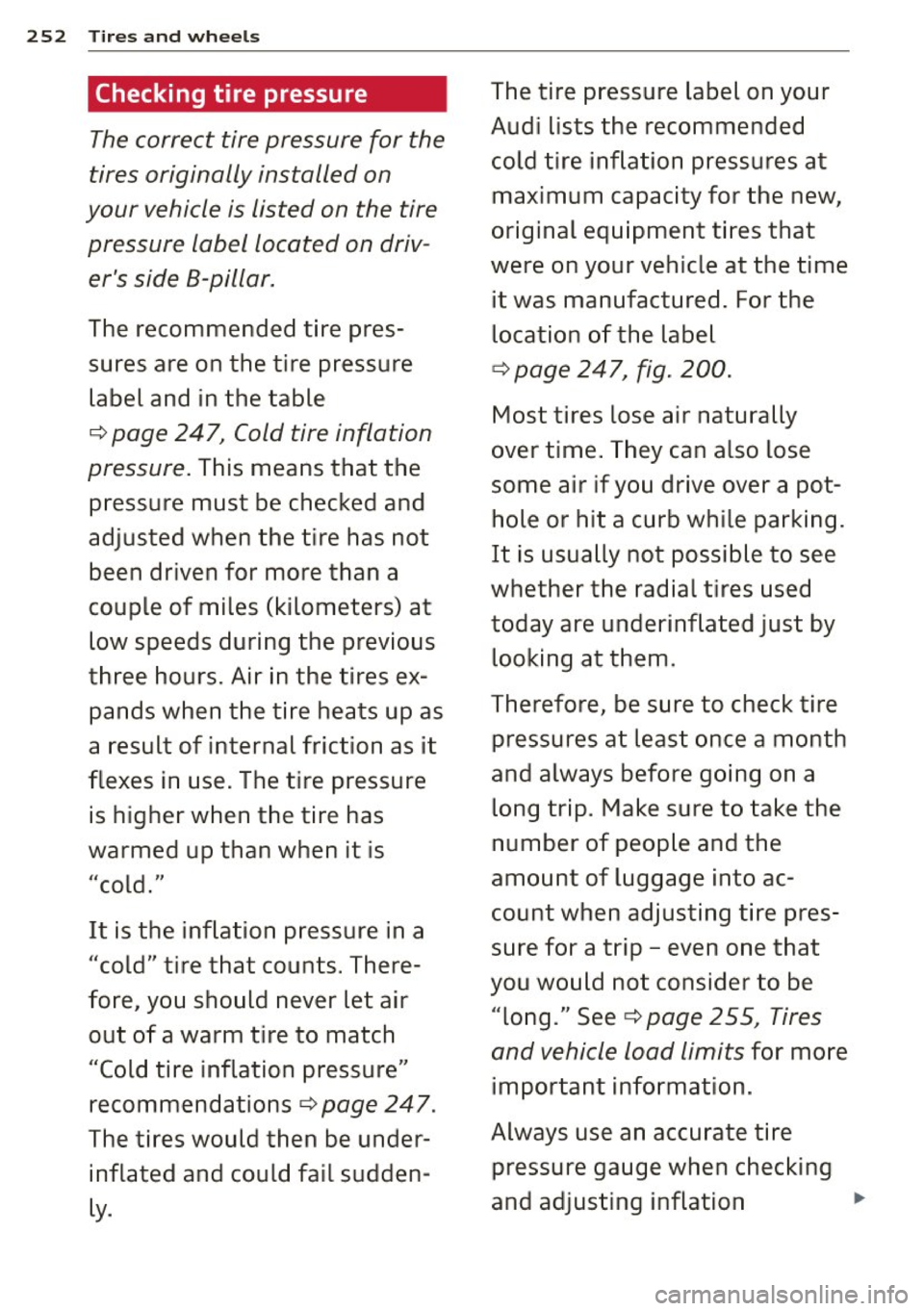
252 Tires and wheels
Checking tire pressure
The correct tire pressure for the
tires originally installed on
your vehicle is listed on the tire pressure label located on driv
er's side 8-pillar.
The recommended tire pres
sures are on the tire pressure
label and in the table
c::> page 247, Cold tire inflation
pressure. This means that the
pressure must be checked and
adjusted when the tire has not
been driven for more than a
couple of miles (kilometers) at
low speeds during the previous
three hours. Air in the tires ex
pands when the tire heats up as
a result of internal friction as it
flexes in use . The tire pressure
is higher when the tire has
warmed up than when it is "cold."
It is the inflation pressure in a
"cold" tire that counts. There
fore, you should never let air
out of a warm tire to match
"Cold tire inflation pressure"
recommendations
c:::> page 247 .
The tires would then be under
inflated and could fail sudden
ly. The tire
pressure label on your
Audi lists the recommended
cold tire inflation pressures at maximum capacity for the new,
original equipment tires that
were on your vehicle at the time
it was manufactured. For the
location of the label
c::> page 247, fig. 200.
Most tires lose air naturally
over time. They can also lose
some air if you drive over a pot hole or hit a curb while parking.
It is usually not possible to see
whether the radial tires used
today are underinflated just by
looking at them.
Therefore, be sure to check tire
pressures at least once a month
and always before going on a long trip . Make sure to take the
number of people and the
amount of luggage into ac count when adjusting tire pres
sure for a trip -even one that
you would not consider to be
"long." See
c:::> page 255, Tires
and vehicle load limits for more
important information .
Always use an accurate tire pressure gauge when checking
and adjusting inflation .,.
Page 255 of 316

Tires and wheels 253
pressures. Check all of the tires It is important to check the tire •
and be sure not to forget the pressure when the tires are • '
spare tire. If the pressure in any cold.
tire is too high when the tire is -Read the required tire pres-
"cold," let air out of the tire sure from the tire pressure la-
slowly with the edge of the tire bel. The tire pressure label is
gauge and keep checking the located on the driver's side B-
pressure until you reach the pillar.
pressure that is correct for the -Turn the valve stem cap coun-
load (passengers and luggage) ter-clockwise to remove it
and kind of driving you plan to from the tire valve.
do. -Place the air pressure gauge
If the pressure in any tire is too on the valve.
low, note the difference be- -The tire pressures should only
tween the pressure in the cold be checked and adjusted when
tire and the pressure you need the tires are cold. The slightly
and add the air that you need to
raised pressures of warm tires
reach the correct pressure for must not be reduced.
the vehicle load (passengers -Adjust the tire pressure to the
and luggage) for the tires on load you are carrying.
your vehicle as listed on the on -Reinstall the valve stem cap
your vehicle and in this manual on the valve.
and the kind of driving you plan
When should I check the tire
to do.
pressure?
Never exceed the maximum in-
The correct tire pressure is es-
flation pressure listed on the
pecially important at high
tire sidewall for any reason.
speeds. The pressure should
Remember that the vehicle therefore be checked at least
manufacturer, not the tire man- once a month and always be-
ufacturer, determines the cor- fore starting a journey. Do not
....
M N
rect tire pressure for the tires <( (.J
'SI:
on your vehicle . .... \!) 1.1'1
.... 1.1'1 ....
Page 256 of 316
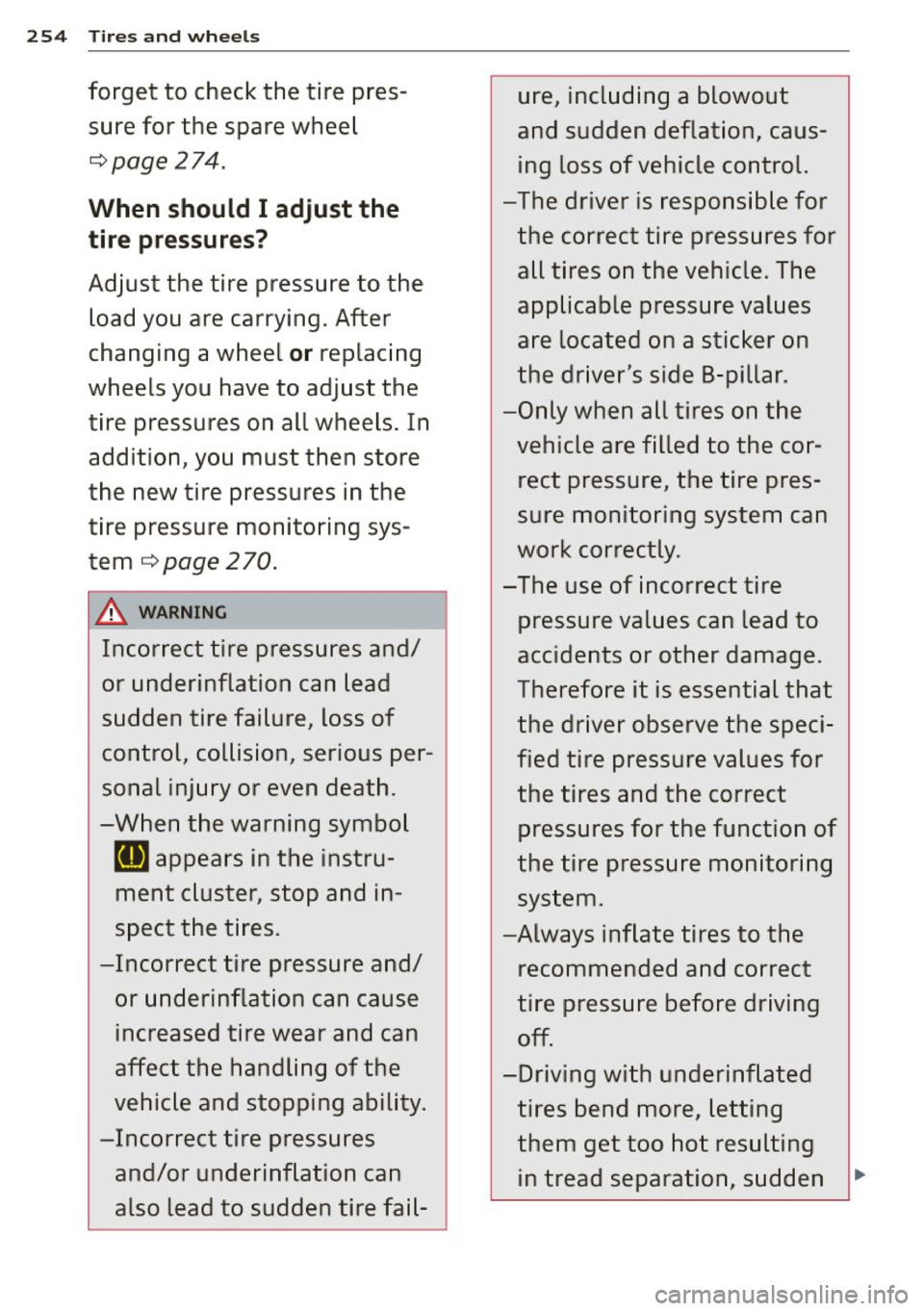
254 Tires and wheels
forget to check the tire pres-
ure, including a blowout
sure for the spare wheel
and sudden deflation, caus-
¢page 274. ing loss of vehicle control.
When should I adjust the -The driver is responsible for
tire pressures? the correct tire pressures for
Adjust the tire pressure to the all tires on the vehicle. The
applicable pressure values
load you are carrying. After
are located on a sticker on
changing a wheel
or replacing
the driver's side B-pillar.
wheels you have to adjust the
-Only when all tires on the
tire pressures on all wheels. In
vehicle are filled to the car-
addition, you must then store
rect pressure, the tire pres-
the new tire pressures in the
sure monitoring system can
tire pressure monitoring sys-
work correctly.
tern
¢ page 270.
-The use of incorrect tire
A WARNING
-pressure values can lead to
Incorrect tire pressures and/
accidents or other damage.
or underinflation can lead Therefore it is essential that
sudden tire failure, loss of the driver observe the speci-
control, collision, serious per- fied tire pressure values for
sonal injury or even death. the tires and the correct
-When the warning symbol pressures for the function of
[IJ appears in the instru-
the tire pressure monitoring
ment cluster, stop and in-
system.
spect the tires. -Always inflate tires to the
-Incorrect tire pressure and/ recommended and correct
or underinflation can cause tire pressure before driving
increased tire wear and can off.
affect the handling of the -Driving with underinflated
vehicle and stopping ability. tires bend more, letting
-Incorrect tire pressures them get too hot resulting
and/or underinflation can in tread separation, sudden
..
also lead to sudden tire fail-
Page 257 of 316
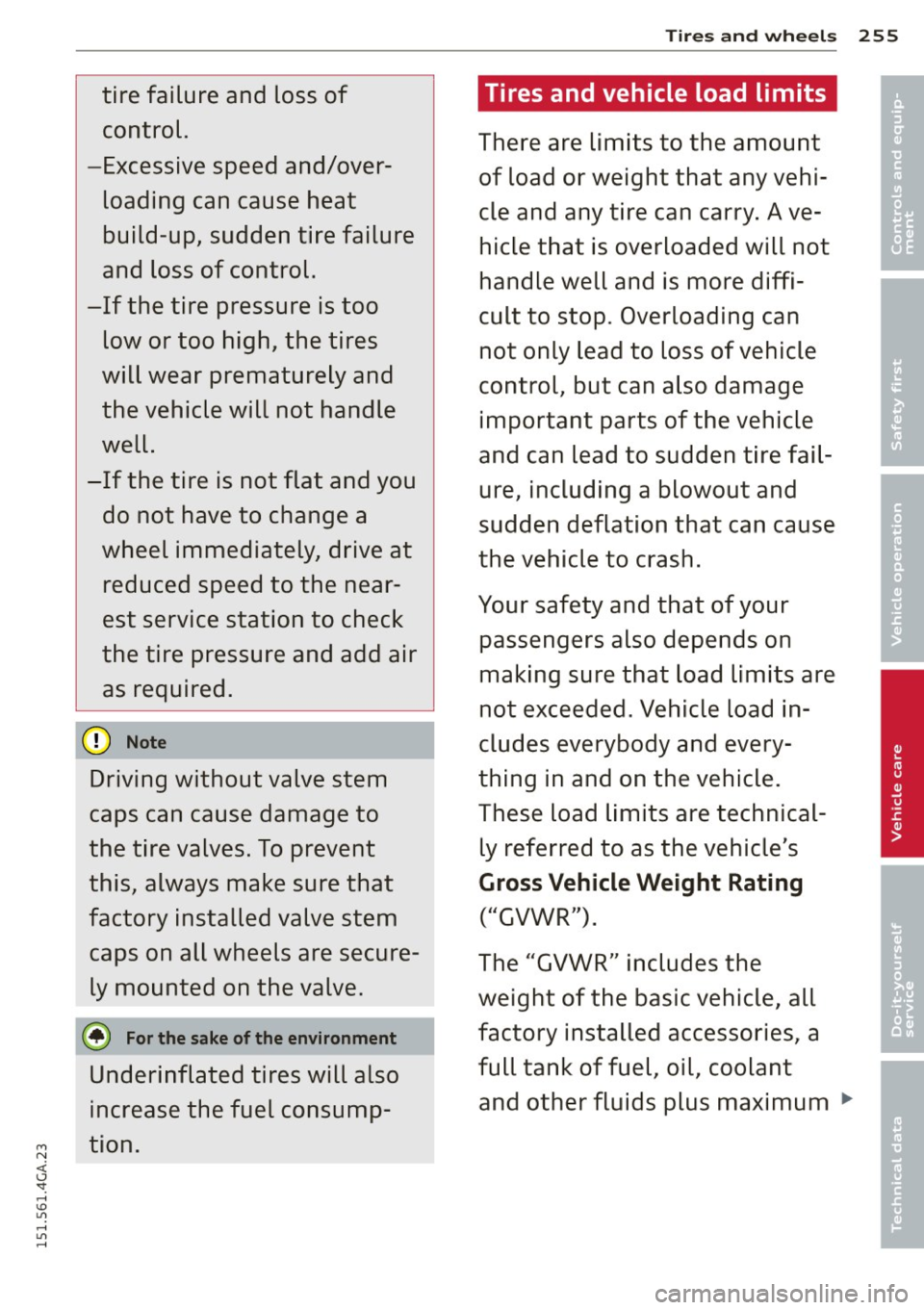
M N <( (.J
'SI: ,...., \!) 1.1'1 ,...., 1.1'1 ,....,
tire failure and loss of
control.
-Excessive speed and/over loading can cause heat
build -up, sudden tire failure
and loss of control.
-If the tire pressure is too low or too high, the tires
will wear prematurely and
the vehicle will not handle
well.
-If the tire is not flat and you do not have to change a
wheel immediately, drive at
reduced speed to the near
est service station to check
the tire pressure and add air as required.
(D Note
Driving without valve stem
caps can cause damage to
the tire valves. To prevent
this, always make sure that
factory installed valve stem caps on all wheels are secure
ly mounted on the valve.
@ For the sake of the environment
Underinflated tires will also
increase the fuel consump
tion.
Tires and wheels 255
Tires and vehicle load limits
'
There are limits to the amount of load or weight that any vehi
cle and any tire can carry. Ave
hicle that is overloaded will not
handle well and is more diffi
cult to stop. Overloading can
not only lead to loss of vehicle
control, but can also damage important parts of the vehicle
and can lead to sudden tire fail
ure, including a blowout and
sudden deflation that can cause
the vehicle to crash.
Your safety and that of your passengers also depends on
making sure that load limits are
not exceeded. Vehicle load in
cludes everybody and every
thing in and on the vehicle .
These load limits are technical ly referred to as the vehicle's
Gross Vehicle Weight Rating
("GVWR").
The "GVWR" includes the
weight of the basic vehicle, all
factory installed accessories, a
full tank of fuel, oil, coolant and other fluids plus maximum ""
•
•
'
Page 258 of 316

256 Tires and wheels
load. The maximum load in
cludes the number of passen
gers that the vehicle is intend
ed to carry ("seating capacity")
with an assumed weight of
150 lbs (68 kg) for each pas
senger at a designated seating
position and the total weight of
any Luggage in the vehicle . If
you tow a trailer, the weight of
the trailer hitch and the tongue
weight of the loaded trailer
must be included as part of the
vehicle load .
The
Gr oss Axle Weight Rating
("GAWR") is the maximum load
that can be applied at each of
the vehicle's two axles.
The Gross Vehicle Weight Rat
ing and the Gross Axle Weight Rating are listed on the safety
compliance sticker label locat
ed on the driver's side 8-pillar .
Your Audi has 4 seating posi
tions, 2 in the front and 2 in the rear for total seating capacity
of 4. In some vehicles there are
5 seating positions, 2 in the
front and 3 in the rear for total seating capacity of 5. Each seat
ing position has a safety belt
¢ page 138, Safety belts.
The fact that there is an upper limit to your vehicle's Gross Ve
hicle Weight Rating means that
the total weight of whatever is being carried in the vehicle (in
cluding the weight of a trailer
hitch and the tongue weight of
the loaded trailer) is limited .
The more passengers in the ve hicle or passengers who are
heavier than the standard
weights assumed mean that less weight can be carried as
luggage.
The tire pressure label on your
Audi also lists the maximum
combined weight of all of the
occupants and luggage or other
cargo that the vehicle can carry. For the Location of the label
¢ page 247, fig . 200 .
_& WARN ING -
Overloading a vehicle can
cause Loss of vehicle control,
a crash or other accident, se
rious personal injury, and
even death.
-Carrying more weight than your vehicle was designed to carry will prevent the ve
hicle from handling properly
~
Page 259 of 316

and increase the risk of the loss of vehicle control.
-The brakes on a vehicle that
has been overloaded may
not be able to stop the vehi
cle within a safe distance.
-Tires on a vehicle that has
been overloaded can fail
suddenly, including a blow
out and sudden deflation,
causing loss of control and a
crash.
-Always make sure that the total load being transported - including the weight of a
trailer hitch and the tongue
weight of a loaded trailer - does not make the vehicle heavier than the vehicle's
Gross Vehicle Weight Rat
ing .
Determining correct load
limit
Use the example below to cal
culate the total weight of the
passengers and luggage or oth
er things that you plan to trans
port so that you can make sure
that your vehicle will not be
~ overloaded.
Steps for Determining
Correct Load Limit
1. Locate the statement "THE
COMBINED WEIGHT OF OC
CUPANTS AND CARGO
SHOULD NEVER EXCEED XXX KG OR XXX LBS" on your ve
hicle's placard (tire inflation
pressure label)
¢ page 247,
fig. 200.
2. Determine the combined
weight of the driver and passengers that will be riding in
your vehicle.
3. Subtract the combined
weight of the driver and pas
sengers from
"XXX" kilo
grams or
"XXX" pounds
shown on the sticker
¢ page 247, fig. 200.
4. The resulting figure equals the available amount of cargo and luggage load capaci
ty. For example, if the
"XXX"
amount equals 1400 lbs.
and there will be five 150 lbs. passengers in your vehi
cle, the amount of available
cargo and luggage load ca
pacity is 650 lbs. (1400-7 50
(5
X 150) = 650 lbs.)
5. Determine the combined
weight of luggage and cargo ""
•
•
'
Page 260 of 316

258 Tires and wheels
being loaded on the vehicle.
That weight may not safely
exceed the available cargo
and luggage load capacity
calculated in Step 4.
6. If your vehicle will be towing
a trailer, load from your trail
er will be transferred to your
vehicle. Consult this manual
to determine how this re duces the available cargo
and luggage load capacity of
your vehicle.
.,.Check the tire sidewall
(¢ page 260, fig. 204) to de
termine the designated load
rating for a specific tire.
Tire service life
The service life of tires depends
on a lot of different things in
cluding proper installation and
balancing, correct tire pressure
and driving style.
Fig. 202 Tire tread: tread wear indi
cators (TWI)
Fig. 203 Rotating tires for more even
wear
Tread Wear Indicator (TWI)
The original tires on your vehi
cle have
1/16 inch (1.6 mm)
high "wear indicators"
¢ fig. 202 running across the
tread. Depending on the make,
there will be six to eight of
them evenly placed around the
tire. Marks on the tire sidewall (for example "TWI" or other
symbols) indicate the positions
of the tread wear indicators.
Worn tires must be replaced. Different figures may apply in
other countries
¢ .&. .
Tire pressure
Incorrect tire pressure causes
premature wear and can cause
sudden tire blow-out. For this
reason, tire press ure must be
checked at least once a month
¢page 252.